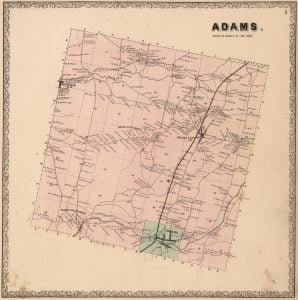
The first settlers of the town had only blind paths through the woods for roads; and when streams were reached, they had to be forded or crossed on foot-logs felled across the narrow channels. But roads were located be-tween the different settlements at an early day, and in 1802 the Sandy creek was bridged at Smith’s mill. In the spring of 1804, the State road to Rome, via Redfield, was opened, and ten years later, the State road from Salina to Adams, where it intersected the Rome road. It was long best known as the ” Salt Point road.”
The bridges at Adams village have been swept off several times by the floods to which Sandy creek is peculiarly liable, and their maintenance has cost the town a considerable sum. A tax of $500 upon the town of Adams was authorized April 13, 1839, for the purpose of building a bridge across the north branch of Big Sandy creek at the village. Liberal appropriations for the improvement of the roads and the building of bridges were voted in 1850 and 1851; in 1853, $1000 was voted for this purpose, and the two succeeding years, $1500; and in 1860, $4000 was voted to be paid in four installments. The town was thoroughly districted and a better class of bridges built. A stone bridge at Adams village was completed in 1863, and the bridges and roads of Adams will now compare favorably with those of other towns in the county.
The certificate of organization of the “Adams and Ellisburg Plank-road Co.” was recorded Feb. 14, 1849. Among those interested in this road were Judge Skinner and others. The plank, being hemlock, soon rotted away, and the road was abandoned about 1855.
The “Rome, Watertown and Ogdensburgh R. R.” was built through Adams in 1851. It traverses the town in a general north and south direction east of the centre, 7.12 miles, and has an elevation above tide, at Adams, of 596 feet, and at Adams Centre, of 600 feet. At both of the points named it has stations, which handle large quantities of freight for those places and the country east and west of the road. There are also a number of express and passenger trains daily, affording easy and rapid communication.
In 1850, O’Reilly’s Merchants’ Telegraph Line was erected along the stage road, and an office opened. Other lines were soon after built along the railroad. At present the Montreal and the Dominion companies have offices at Adams, and the former an office at the Centre.
The importance of Henderson Harbor as a lake-port, and the necessity of having a line of railway leading through northern New York and the New England States, which is not subject to snow blockades, and, at the same time, affords local traffic by passing through a fertile country, led to the formation of the “Boston & Henderson Harbor R. R. Company,” at Adams, April, 1872. The articles of association provide for a route from Henderson Harbor, through Jefferson, Lewis, and Oneida counties, into Herkimer, to Salisbury, there to intersect with a road leading to Boston via Hoosac Tunnel. The capital stock, was fixed at $2,000,000, and the length of the road estimated at 108 miles; $80,000 having been subscribed, a board of directors was chosen, consisting of S. D. Hungerford, W. A. Gilbert, G. W. Bond, and D. A. Dwight, Adams; W. P. Davis and Simeon Mather, Henderson; Charles P. Riggs, Turin; W. D. Allport and Elam Cooley, Rodman; John C. Wright and Lucien Clark, Copenhagen; John B. Clark, Woodville; and Arnold Webb, South Rutland.
May 15, 1872, officers were elected: S. D. Hungerford, president; J. C. Wright, vice-president; D. A. Dwight, secretary; and G. W. Bond, treasurer. At the same time. Octave Blanc, C.E., was appointed to make a survey under the general direction of John C. Wright, the chief instigator and promoter of the project. From his report, made to the board at Adams, Jan. 16, 1873, it was learned that a favorable route could be secured passing through the town of Adams, south of the village, at an estimated cost of $19,621.54 per mile. Measures were taken to raise the required stock by enlisting capitalists, when the financial crisis of 1873 intervened, and the prosecution of the work has been temporarily abandoned.
Source: Durant, Samuel W. and Henry B. Peirce. History of Jefferson County, New York, With Illustrations and Biographical Sketches of Some of its Prominent Men and Pioneers. Philadelphia: L.H. Everts & Co., 1878. p 244-245.
